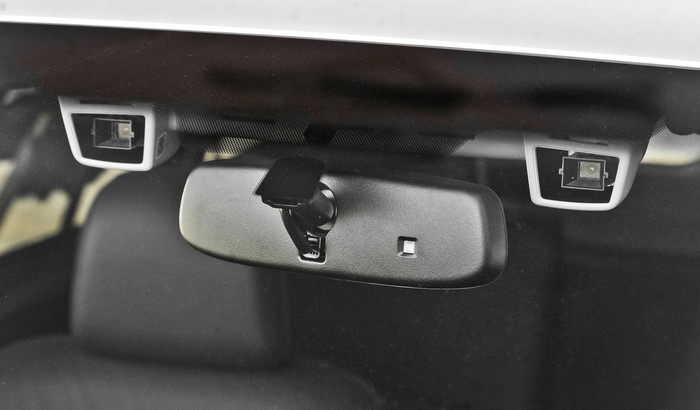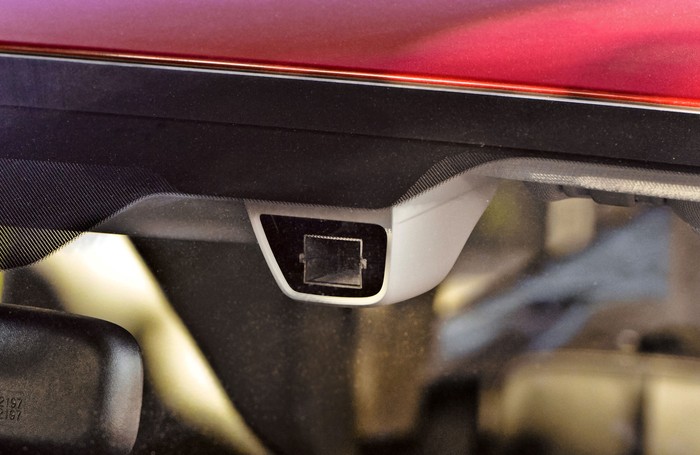

Spotlight On: Subaru EyeSight
An in-depth look at Subaru\'s suite of safety technologies.
Cameras and sensors are rapidly making their way into new cars, but few systems are as complete - and affordable - as Subaru's EyeSight, which arrived on the scene for the 2013 model year.
EyeSight's name gives away at least part of its utility. Using a pair of stereo-lithic cameras (think two cameras) mounted on either side of the rearview mirror, EyeSight keeps an eye on the road ahead for a number of safety-related functions: Adaptive Cruise Control, Lane Departure and Lane Sway Warning, Pre-Collision Braking and Pre-Collision Throttle Management.
Just what does all that mean? Read on.
EyeSight explained
EyeSight debuted in the United States on the 2013 Subaru Legacy and Outback, but the suite of technologies is being added to other Subaru products. Eventually, Subaru plans to offer EyeSight on every one of its vehicles.
Though not the most elegant system - it consists of a large, plastic-covered pack that mounts to the vehicle's headliner near the rearview mirror - it does offer a particularly wide range of safety functions not typically available in the non-premium segment.
The two cameras can see up to 87 yards ahead of the vehicle and they have a 25 degree angle of view to keep tabs on other lanes. They're black and white only, which means they won't be used to display anything on a screen inside the cabin. They also don't record anything - there is no built-in hard drive.
The cameras are programmed to recognize vehicles including motorcyclists, bicyclists and pedestrians, but Subaru warns that pedestrians crossing the street are difficult for them to spot.
Once the cameras detect a potential obstruction, they send a signal to another component of the vehicle - the brakes, the accelerator or an instrument cluster-mounted warning light designed to alert the driver to do something.
Notably, Subaru says that the cameras' functionality can be limited by a dirty windshield in inclement weather conditions.
EyeSight's main components are pretty easy to explain. First, here's a quick overview video Subaru has provided.
Adaptive Cruise Control. Set-it-and-forget-it cruise control systems aren't new, but it has taken them a while to become available on moderately-priced cars like the Subarus. When cruise control is engaged, the cameras monitor the lane ahead to keep a pre-set distance between you and other vehicles.
The system works from just 1 mph to 87 mph, which means it can be used for stop-and-go-style traffic. In fact, the system can bring the car to a complete halt if needed (think heavy traffic situations) and it will alert drivers if traffic begins to move again (the system won't start accelerating on its own once it has come to a stop). This latter mode is called Lead Vehicle Start Alert in Subaru-speak.
In practice, we found that the system worked well at highway speeds, but its usefulness in urban stop-and-go traffic was limited given that it maintains a "safe” distance between vehicles. In other words, more aggressive drivers tend to be prone to sneaking in.
Lane Departure Warning. The cameras keep tabs on line marking stripes to determine whether a vehicle has left its lane. If the driver uses the turn signal, the system turns off temporarily. If the system detects an unintended lane departure, it emits a shrill audible alert and the cluster warning light.
In addition, the system features a Lane Sway Warning that provides a similar warning if it detects that the driver is wandering within his or her lane.
Subaru's system does not include a blind spot monitor, which would alert drivers to a vehicle sitting in their blind spot via a light and, usually, an audible beep.
We found that the lane departure system generally worked well, but we had a hard time consistently replicating unintentional lane sway that would have activated an alert.
Pre-Collision Braking. If the cameras detect an impending collision, a three-step process is designed to first alert drivers and then provide progressively strong automatic braking to prevent or limit the force of an accident.
First, the system warns drivers with a loud beep and a light on the instrument cluster. If the driver doesn't immediately react by putting his or her foot on the brake, the system applies moderate braking pressure. If the driver still doesn't hit the brakes, the system applies strong braking force and it can entirely halt the vehicle.
The system can only bring the car to a complete stop below 19 mph, which is useful for high traffic or urban conditions. At higher speeds, it is intended only to mitigate the effects of an impact.
In a controlled situation (foot hovering off the brake), we witnessed Pre-Collision Braking working as intended at a low speed. The Forester we used as a test vehicle came to a complete halt a couple of feet away from a stationary object. Without the system, there would have been damage to the test vehicle.
Pre-Collision Throttle Management
Try to plow into the stopped vehicle or stationary object in front of you and EyeSight will cut the throttle. Pre-Collision Throttle Management is most useful in instances where the car in front of you begins to move but suddenly hits the brakes - like in a sharp right-hand turn into traffic situation.
In addition, Subaru says that the system is designed to reduce the risk of running over a curb if the throttle is hit instead of the brakes.
If you really want to bump into something, the system can be turned off entirely.
Though we see limited usefulness for the system's ability to detect curbs that are already under a vehicle's front bumper, Pre-Collision Throttle Management could easily reduce the accident risks associated with the very real right-hand turn scenario.
Leftlane's bottom line
Subaru's decision to bundle a bunch of camera-based safety tech into one package is a boon for consumers, but we wish the automaker would offer the features on more trim levels of more models. As of press time, only some of the higher-spec, lower-volume trim levels offer EyeSight.
Though EyeSight isn't as attractively integrated into Subaru models' roofs as it could be, the system still seems worth adding to us - if you're looking for a higher-end Subaru.
Leftlane's Spotlight On series aims to provide new car shoppers with an in-depth look and critical evaluation of new technologies and features. Since high-tech items tend to evolve quickly, it is important to note that the information presented here is accurate as of the publish date above.
